
Basket
Portland Art Museum
91.95.42
Panamint baskets are usually coiled and are traditionally decorated with geometric designs. Tick marks around the rim are another traditional element. By about 1920 the designs on Panamint baskets were becoming increasingly complex, incorporating figurative motifs such as humans, birds, animals, ...
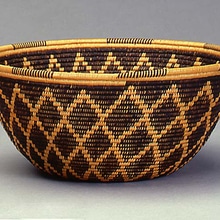
Basket
Portland Art Museum
91.95.41
Panamint baskets are usually coiled and are traditionally decorated with geometric designs. Tick marks around the rim are another traditional element. By about 1920 the designs on Panamint baskets were becoming increasingly complex, incorporating figurative motifs such as humans, birds, animals, ...

Basket
Portland Art Museum
91.95.38
This basket is a round-walled variety of the Washo fancy basket (it is called degikup). The design on the basket is organized by a meandering band of patterns known as matcati le'lup (arrowhead opposed), referring to the triangles on the corners of the zigzag band. This band isolates large open a...

Basket
Portland Art Museum
91.95.37
Annie Poole McBride, a master Paiute basket maker, lived around Bishop, California. This finely coiled basket is identified as her creation by the six-pointed star often used on her baskets. Many Paiute basket makers entered their works in competition at local fairs, which not only gained fame an...
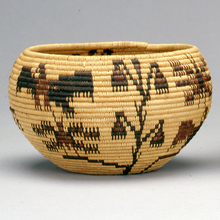
Basket
Portland Art Museum
91.95.36
The Elizabeth Cole Butler Collection.
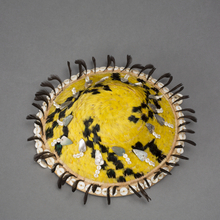
Gift Basket
Portland Art Museum
91.95.35
Feathered baskets were an important trade item and a symbol of wealth among the Pomo. They were considered appropriate gifts at special occasions and were used as offerings at funerals and mourning ceremonies. The brightly colored feathers, added to the basket as it is made, provide a design mosa...

Basket
Portland Art Museum
91.95.34
The Pomo are seven distinct cultural groups that historically occupied the California coast from south of the Russian River northward to the Fort Bragg area and inland to the region around Clear Lake. Although the Pomo made a variety of baskets, they are best known for finely coiled baskets such ...
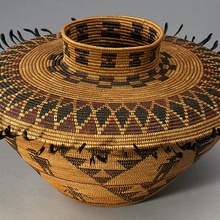
Basket
Portland Art Museum
91.95.25
The Yokuts are some forty to sixty linguistically related tribal groups that historically lived in the San Joaquin valley and adjacent Sierra Nevada foothills of California. They made a variety of coiled basketry forms, including jars with distinct flat shoulders and short, vertical necks. Figura...
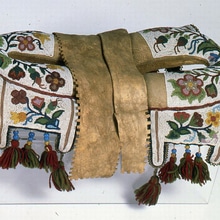
Pad Saddle
Portland Art Museum
91.95.21
By the mid-eighteenth century horses had spread throughout the Plains region. As Plains Indian peoples became expert horsemen, they began to create a variety of trappings for their horses. Derived from Spanish pack saddles, pad saddles were commonly made by peoples of the northern and northeaster...

mask
Portland Art Museum
91.95.20
The Elizabeth Cole Butler Collection.